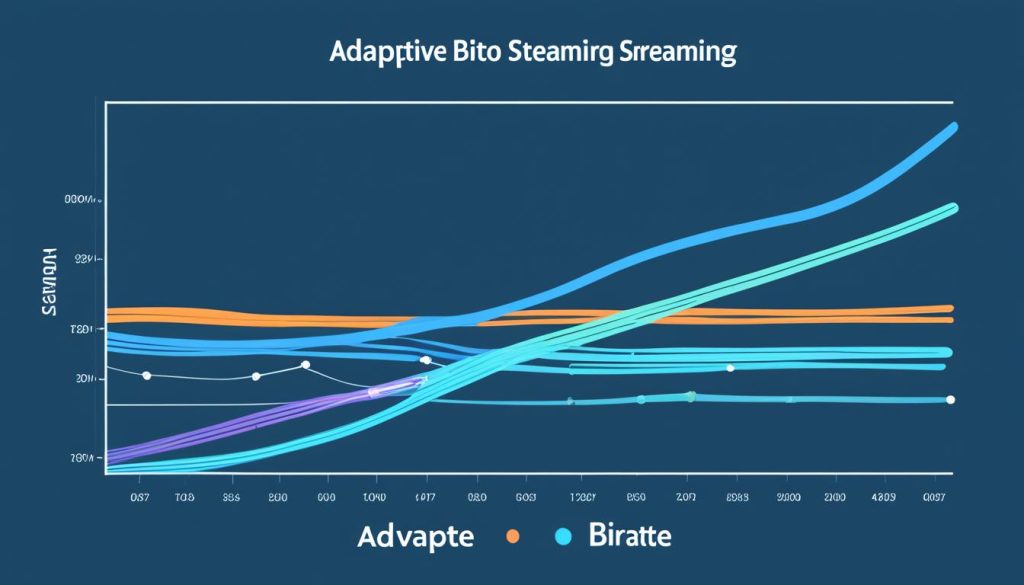Adaptive bitrate streaming is a technique used in streaming multimedia over computer networks. It works by detecting a user’s bandwidth and CPU capacity in real time, adjusting the quality of the media stream accordingly. This results in providing very little buffering, faster start times and a good experience for both high-end and low-end connections. Adaptive bitrate streaming is based almost exclusively on HTTP and is designed to work efficiently over large distributed HTTP networks.
Post-production houses, content delivery networks and studios use adaptive bitrate technology in order to provide consumers with higher quality video using less manpower and fewer resources. The creation of multiple video outputs, particularly for adaptive bitrate streaming, adds great value to consumers. If the technology is working properly, the end user or consumer’s content should play back without interruption and potentially go unnoticed. Media companies have been actively using adaptive bitrate technology for many years and it has essentially become standard practice for high-end streaming providers.
Key Takeaways
- Adaptive bitrate streaming dynamically adjusts video quality based on network conditions for seamless playback.
- It works by detecting a user’s bandwidth and CPU capacity in real-time to provide a good experience for both high-end and low-end connections.
- Adaptive bitrate streaming is based on HTTP and designed to work efficiently over large distributed HTTP networks.
- The technology is used by post-production houses, content delivery networks and studios to provide consumers with higher quality video using fewer resources.
- Adaptive bitrate streaming has become a standard practice for high-end streaming providers.
Understanding Adaptive Bitrate Streaming
Adaptive bitrate streaming is a powerful technique that dynamically adjusts video quality based on network conditions, ensuring seamless playback without buffering or interruptions. This technology works by detecting a user’s bandwidth and CPU capacity in real time, adjusting the quality of the media stream accordingly. The result is a superior viewing experience for both high-end and low-end connections, with very little buffering and faster start times.
Adaptive Streaming Overview
Adaptive bitrate streaming is a method of video streaming over HTTP where the source content is encoded at multiple bit rates. Each of the different bit rate streams are segmented into small multi-second parts. The client downloads a manifest file that describes the available stream segments and their respective bit rates. During stream start-up, the client usually requests the segments from the lowest bit rate stream. If the client finds that the network throughput is greater than the bit rate of the downloaded segment, then it will request a higher bit rate segment. Later, if the client finds that the network throughput has deteriorated, it will request a lower bit rate segment. An adaptive bitrate (ABR) algorithm in the client performs the key function of deciding which bit rate segments to download, based on the current state of the network.
Adaptive Streaming in Action
Adaptive bitrate streaming requires the use of an encoder which encodes a single source media (video or audio) at multiple bit rates. The player client then switches between streaming the different encodings depending on available resources. This dynamic adjustment of video quality ensures a seamless viewing experience, with very little buffering and faster start times.
Current Uses
Post-production houses, content delivery networks and studios use adaptive bitrate technology in order to provide consumers with higher quality video using less manpower and fewer resources. The creation of multiple video outputs, particularly for adaptive bitrate streaming, adds great value to consumers. If the technology is working properly, the end user or consumer’s content should play back without interruption and potentially go unnoticed. Media companies have been actively using adaptive bitrate technology for many years and it has essentially become standard practice for high-end streaming providers.

What is adaptive bitrate streaming in IPTV?
Adaptive bitrate streaming is based almost exclusively on HTTP, and is designed to work efficiently over large distributed HTTP networks. HTTP-based adaptive bitrate streaming technologies yield additional benefits over traditional server-driven adaptive bitrate streaming.
HTTP-Based Streaming Technologies
First, since the streaming technology is built on top of HTTP, contrary to RTP-based adaptive streaming, the packets have no difficulties traversing firewall and NAT devices. Second, since HTTP streaming is purely client-driven, all adaptation logic resides at the client. This reduces the requirement of persistent connections between server and client application. Furthermore, the server is not required to maintain session state information on each client, increasing scalability. Finally, existing HTTP delivery infrastructure, such as HTTP caches and servers can be seamlessly adopted.
Benefits of Adaptive Bitrate Streaming
Adaptive bitrate streaming provides consumers of streaming media with the best-possible experience, since the media server automatically adapts to any changes in each user’s network and playback conditions. The media and entertainment industry also benefit from adaptive bitrate streaming. As the video space grows, content delivery networks and video providers can provide customers with a superior viewing experience. Adaptive bitrate technology requires additional encoding, but simplifies the overall workflow and creates better results.
History of Adaptive Bitrate Streaming
Adaptive bitrate over HTTP was created by the DVD Forum at the WG1 Special Streaming group in October 2002. The group was co-chaired by Toshiba and Phoenix Technologies, The expert group count with the collaboration of Microsoft, Apple Computer, DTS Inc., Warner Brothers, 20th Century Fox, Digital Deluxe, Disney, Macromedia and Akamai. The technology was originally called DVDoverIP and was an integral effort of the DVD ENAV book. Adaptive bitrate streaming was later introduced by Move Networks and is now being developed and utilised by Adobe Systems, Apple, Microsoft and Octoshape.
Conclusion
Adaptive bitrate streaming has become a critical technique in the world of multimedia streaming over computer networks. By dynamically adjusting video quality based on real-time network conditions, this technology ensures a seamless playback experience for viewers, with minimal buffering or interruptions. Whether it’s IPTV, adaptive video streaming, or dynamic bitrate adaptation, the underlying principle remains the same – optimising video quality and bandwidth to provide the best possible experience for both high-end and low-end connections.
The use of HTTP-based streaming technologies, such as MPEG-DASH and HTTP Live Streaming (HLS), has allowed adaptive bitrate streaming to work efficiently over large, distributed content delivery networks (CDNs). This, in turn, has enabled media companies and streaming providers to offer their customers a superior viewing experience, with video quality optimisation and bandwidth optimisation at the forefront.
As the demand for high-quality, uninterrupted video content continues to grow, adaptive bitrate streaming has become a standard practice for high-end streaming providers. This technology allows them to deliver an exceptional experience to their consumers while optimising their own resources and workflows. With its proven track record and ongoing advancements, adaptive bitrate streaming is poised to remain a crucial component of the evolving multimedia landscape.
FAQ
What is adaptive bitrate streaming in IPTV?
Adaptive bitrate streaming is a technique used in streaming multimedia over computer networks. It works by detecting a user’s bandwidth and CPU capacity in real time, adjusting the quality of the media stream accordingly. This results in providing very little buffering, faster start times and a good experience for both high-end and low-end connections.
How does adaptive bitrate streaming work?
Adaptive bitrate streaming works by detecting a user’s bandwidth and CPU capacity in real time, adjusting the quality of the media stream accordingly. This requires the use of an encoder which encodes a single source media (video or audio) at multiple bit rates. The player client switches between streaming the different encodings depending on available resources.
What are the benefits of adaptive bitrate streaming?
Adaptive bitrate streaming provides consumers of streaming media with the best-possible experience, since the media server automatically adapts to any changes in each user’s network and playback conditions. The media and entertainment industry also benefit from adaptive bitrate streaming, as it simplifies the overall workflow and creates better results.
How is adaptive bitrate streaming used in the industry?
Post-production houses, content delivery networks and studios use adaptive bitrate technology in order to provide consumers with higher quality video using less manpower and fewer resources. The creation of multiple video outputs, particularly for adaptive bitrate streaming, adds great value to consumers.
What are the underlying technologies for adaptive bitrate streaming?
Adaptive bitrate streaming is based almost exclusively on HTTP and is designed to work efficiently over large distributed HTTP networks. HTTP-based adaptive bitrate streaming technologies yield additional benefits over traditional server-driven adaptive bitrate streaming.
What is the history of adaptive bitrate streaming?
Adaptive bitrate streaming was originally called DVDoverIP and was an integral effort of the DVD ENAV book. The technology was later introduced by Move Networks and is now being developed and utilised by Adobe Systems, Apple, Microsoft and Octoshape.



